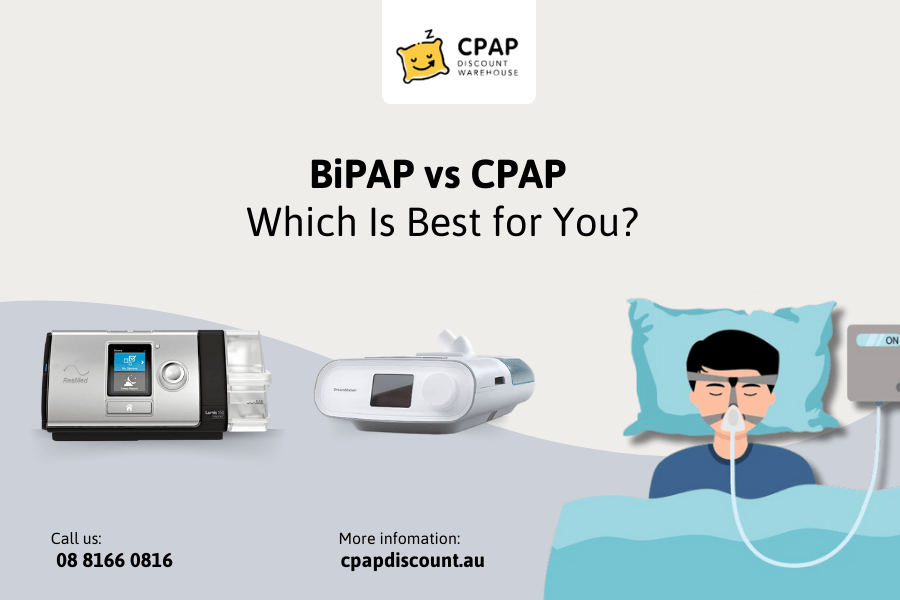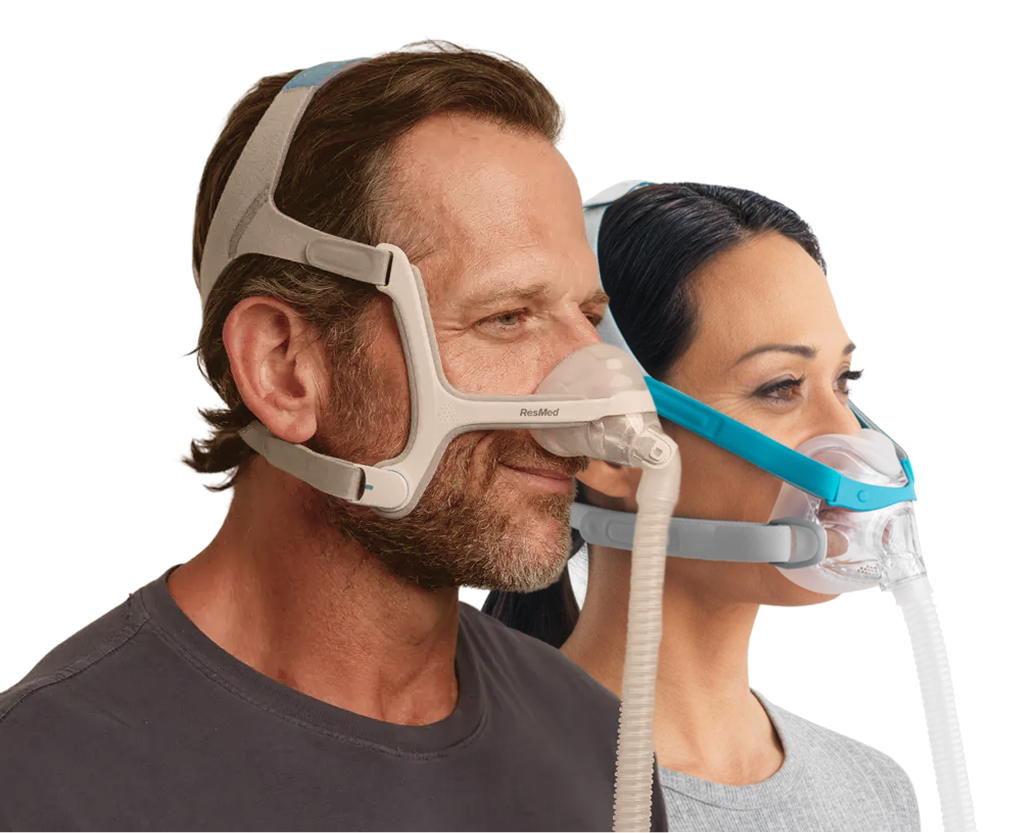Continuous Positive Airway Pressure (CPAP) and Bi-level Positive Airway Pressure (BiPAP) are two types of positive airway pressure systems used to treat sleep apnea. Both PAP therapies work through machines that help direct air into the lungs and airways.
While BiPAP and CPAP machines are similar, they differ in how they operate. Additionally, the decision to choose the right type of PAP machine depends on your specific situation. In this article, CPAP Discount Warehouse will discuss the differences between BiPAP and CPAP, particularly their features, indications, and who they are ideal for.
What is the difference between CPAP and BiPAP?
CPAP and BiPAP machines are both forms of positive airway pressure treatments for sleep apnea, which use compressed air to open and support your upper airway during sleep. Both machines release pressurized air and direct it through a hose and mask component.

Pressure
CPAP machines provide a continuous and adjustable pressure that remains the same when breathing in and out. A CPAP machine typically delivers air pressure between 3 and 20 cm H₂O, while some models now include a pressure relief option that allows for gentler airflow during exhalation.
BiPAP machines, on the other hand, offer two different pressure levels: one for inhalation (Inspiratory Positive Airway Pressure, or IPAP) and a lower one for exhalation (Expiratory Positive Airway Pressure, or EPAP). BiPAP machines generally have a pressure range of 4 to 30 cm H₂O.
Notably, both BiPAP and CPAP settings must be determined during an overnight sleep study.
Cost and Insurance Coverage
While some insurance plans provide coverage for both BiPAP and CPAP machines for obstructive sleep apnea (OSA), they usually require proof that CPAP treatment is inadequate or not well tolerated before approving reimbursement for a BiPAP machine. CPAP devices typically cost between $500 and $1,000, while BiPAP machines require additional sensors and settings, making them more expensive — usually ranging from $1,700 to $3,000.
CPAP machines are often covered by private health insurance. We recommend checking with your insurance provider about coverage for CPAP essentials, such as masks or replacement parts. If you use Medicare and require a CPAP machine, you may be eligible for a three-month trial period. After that, you will need to consult your doctor to review data from your trial period. Medicare may then consider continuing coverage for your CPAP machine.
BiPAP machines may only be covered by your insurance or Medicare if you meet certain criteria. If you are not intolerant to CPAP therapy or if CPAP treatment is effective in managing your sleep apnea, a BiPAP machine may not be covered.
Recommended Use for CPAP and BiPAP
It really depends on the type of sleep apnea you have, as different machines work better for different conditions, though there is some overlap. A CPAP machine is generally recommended for those who have obstructive sleep apnea (OSA), while a BiPAP machine is most commonly used to treat Central Sleep Apnea (CSA), as well as certain heart, lung, and neurological disorders that require structured airway support during sleep.
|
Feature |
CPAP |
BiPAP |
|
Pressure levels |
1 |
2 |
|
Range of Pressure |
4-20 cm H20 |
4-30 cm H20 |
|
Cost |
$500 – $1,000 |
$1,700 – $3,000 |
|
Insurance Coverage |
Yes, but coverage varies by provider and policy |
Only be covered by your insurance company or Medicare if you meet certain criteria |
What Is CPAP?
A Continuous Positive Airway Pressure (CPAP) machine is a medical device used to treat sleep apnea by delivering a constant stream of pressurized air usually between 4 and 20 cm H2O into a user’s airway during sleep. This steady airflow prevents pauses in breathing caused by airway collapse, allowing users to breathe normally throughout the night.
A CPAP machine typically includes a motor that generates air pressure, a hose that carries the air, and a cushioned mask worn over the nose or mouth. Some modern models include heated humidifiers to reduce dryness in the nasal passages and throat. CPAP machines come in various sizes from standard home units to compact travel CPAP machine models, some equipped with backup batteries and FAA approval for in-flight use.
Unlike BiPAP devices, CPAP machines' air pressure for inhalation and exhalation are set at the same level. While some people may find it slightly difficult to exhale at first, most users adjust comfortably over time.
The optimal pressure setting for each user must be determined through a sleep study conducted by a doctor or sleep specialist.
>>> What is a CPAP Machine? Choosing the Perfect CPAP Machine
What Is BiPAP?
BiPAP machine delivers two pressure levels: a higher inspiratory pressure (IPAP) to keep the airway open during inhalation and a lower expiratory pressure (EPAP) to make exhalation feel natural. Typical pressure capability spans ~4–30 cm H₂O. Like CPAP, BiPAP systems include a motorized unit, tubing, and a mask, but they differ by providing separate inhale/exhale pressures.
Operating modes
+ Spontaneous (S): The device senses the user’s breaths and switches between IPAP and EPAP automatically; most users rely on this.
+ Spontaneous/Timed (S/T): Primarily spontaneous, but adds a backup rate if breathing slows below a set threshold, the machine triggers breaths.
+ Timed (T): Cycles strictly by a timer rather than patient effort; used less often because S/T offers similar support with added responsiveness.
Pressure settings
+ Fixed BiPAP: Pre-set IPAP/EPAP that do not change overnight.
+ Auto-adjusting BiPAP (auto-BiPAP): Provides preset ranges for IPAP and EPAP and adapts throughout the night to the sleeper’s needs.

>>>> APAP vs CPAP: Key Differences & Benefits for Sleep Apnea
When to use CPAP vs BiPAP?
CPAP therapy is considered the first-line, non-invasive treatment for obstructive sleep apnea (OSA) due to its simplicity, affordability, and proven effectiveness. It is also used for individuals with severe COPD, congestive heart failure, medication-related breathing issues, or certain airway abnormalities.
BiPAP is useful when fixed, single-pressure CPAP is poorly tolerated or insufficient, including in obstructive sleep apnea (OSA) non-responders, central sleep apnea (CSA), hypoventilation, and coexisting cardiopulmonary conditions such as COPD and congestive heart failure. By lowering exhalation pressure and offering backup rate options, BiPAP supports more natural breathing and ensures adequate breaths per minute when needed.
BiPAP vs CPAP: Which Is Best for You?
Although BiPAP and CPAP machines have similar designs and functions, their differences can significantly impact sleep apnea treatment. Therefore, the decision to switch from one to the other should always be made with your doctor.
For those using a CPAP machine, there is often an adjustment period to get comfortable trying different mask types, fine-tuning settings, or using features that reduce air pressure. CPAP therapy is the best option for obstructive sleep apnea (OSA) that isn’t complicated by other respiratory conditions. By contrast, BiPAP therapy suits people who cannot tolerate CPAP or do not respond adequately to CPAP treatment.






